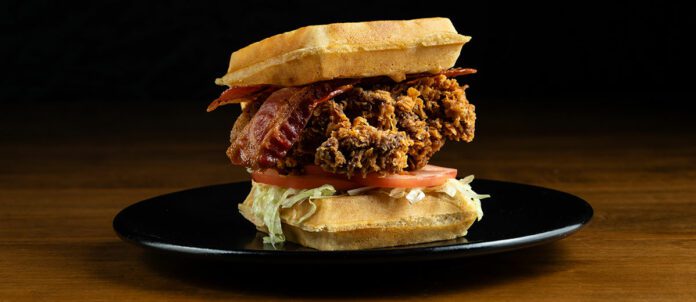By Sarah B. Hood
Chicken is hot these days, in more ways than one. Literally, of course, diners are still flocking to order batter-fried birds in spicy sauces. More significantly, the fried-chicken niche offers a case study in post-COVID restaurant entrepreneurship.
While larger and more established outlets were wilting on the vine during pandemic lockdowns, feisty new chefs harnessed an already-emerging trend to launch innovative businesses, often jump-starting a brick-and-mortar debut with food-truck and pop-up appearances, building up reputation before committing to a lease.
For instance, husband and wife Monia Elhayek and Shad Haidar launched a fried-chicken business called BTRMLK in London, Ont. in April 2020, just as COVID hit. They started out selling to friends from a garage, then ran pop-ups in a taco shop owned by friends. Their first storefront opened in February 2021; they have since added a second location.
It’s the same all across the country. Despite a few casualties (such as Edmonton’s Northern Chicken, which recently shuttered its two outlets), hip, lean, Instagram-friendly fried-chicken eateries are showing remarkable resilience after opening at the worst of times.
Foodservice and Hospitality noted the 2020 openings of The Heartbreak Chef in Etobicoke, Ont. and Birdies in east-end Toronto. Both founded from food-truck successes, they are still going strong. (In 2023, Birdies’ owners Kevin Green and Amanda Louie added a trendy ice-cream boutique next door.) Montreal’s Jack le Coq, with a local-food focus, has expanded to six locations since its March 2021 opening.
In 2021, Frying Pan likewise spun off from a top-performing Vancouver food-truck business. “In four years, we built our company to almost $1 million in revenue, so we were able to find a brick-and-mortar location,” says general manager Doosung Kim. With landlords struggling to fill spaces, “[during] COVID it was to our advantage to move into brick-and-mortar.”
Korean chicken is the draw at Frying Pan, but when the food truck launched in 2017, “it was relatively unknown in North America,” says Kim. “With the popularity of Korean culture, Korean fried chicken, with its light batter and a lot of crispiness, became very popular.”
As Nashville hot-fried chicken began to attract diners’ attention, Frying Pan’s concept was “to incorporate the lightness and the crispiness with the hotness of Nashville hot chicken,” says Kim.
Innovative chicken recipes may attract foodies with international flavour profiles such as Japanese karaage, sweet and spicy Korean yangnyeom and Filipino proben, but for more down-to-earth diners, it’s simply a familiar comfort food. Thus, it’s still a go-to for family restaurants such as Toronto’s 32-year-old Jawny Bakers, an east-end neighbourhood staple serving steaks, salads, sandwiches and pastas.
“Chicken is more popular now because of a price-conscious consumer,” says managing partner Tom Zoras. Jawny Bakers uses only fresh meat from The Butcher Shoppe in Etobicoke, Ont., cooked à la minute. Its clientele is more traditional than trendy, so menu additions are conservative, such as a Penne Athena pasta (chicken with goat cheese, sundried tomato, pesto-tomato sauce, roasted red pepper and spinach) and a schnitzel-style Peppercorn Chicken.
Chicken is also buoying up the fortunes of big international chains, served in meals such as Thai hot chicken bowls or grilled chicken poke bowls, and especially as crispy fried chicken fuelled by peppery spices.
“Spicy chicken has seen a 4.3-per-cent increase over the last five years in menu penetration throughout the Canadian marketplace,” says David Cocker, director of Culinary Innovation and Marketing with Reuven International Ltd, which is seeing growing enthusiasm for its chicken karaage: skin-on marinated, breaded and cooked thigh meat with a ginger-sesame-soy flavour profile.
Speaking to these trends, in late 2023, Popeyes added new chicken-wing flavours — Honey BBQ, Roasted Garlic Parmesan, Signature Hot and Honey Garlic — and brought back Ghost Pepper. In early 2024, it introduced a Crispy Chicken Wrap featuring chicken tenders in Buffalo sauce.
Last February, Tim Hortons launched Sweet Chili Chicken as a wrap or bowl. In March, Taco Bell Canada’s new Cantina Chicken Menu arrived with tacos, burritos and quesadillas seasoned with Mexican spices, pico de gallo and Avocado Ranch Sauce. Mary Brown’s started serving its new Korean-inspired, soy-garlic glazed K-Crunch sandwich in late March.
There’s so much interest in chicken that an intersection in Burlington, Ont., west of Toronto, has lately been dubbed “Chicken Corner” for its conglomeration of competing chicken concepts that is attracting social-media comparisons: Dave’s Hot Chicken, Church’s, Popeyes and Mary Brown’s, with rumours of a Chick-Fil-A soon to arrive, and the second outlet of MightyBird, a fried-chicken brand developed by Open Concept Hospitality with Eat Up Canada!
The first MightyBird launched in late 2023 in Toronto’s recently re-designed Union Station, serving fresh dark meat with numerous seasonings. Crispy chicken-sandwich offerings include the Mighty O.G. with coleslaw, banana pepper, maple-honey syrup and buttermilk ranch; the Crispy Chicken Waffle Club; and the popular Nashville Lightning Hot.
“Nashville chicken has become a huge trend; we have a custom hot sauce and three levels of heat,” says operating partner Dan Kennedy. MightyBird also offers a Piri-Piri Griled Chicken sandwich; its tacos include Banh Mi Crispy Chicken tossed in a sweet and spicy Korean gochujang-style sauce.
Asian or American, sweet, spicy, creamy or crunchy, breast or thigh, chicken’s ability to play nicely with almost any flavour profile or preparation method is continuing to support foodservice operators as they adapt to the long-term effects of post-pandemic disruption.


















